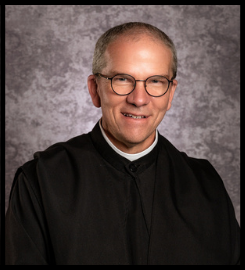
A man cannot enter into the deepest center of himself and pass through that center into God, unless he is able to pass entirely out of himself and empty himself and give himself to other people in purity of a selfless love (New Seeds of Contemplation, 64).
So that they all may be one, as you, Father, are in me and I in you, that they also may be in us, that the world may believe that you sent me (Jn. 17.21).
In chapter nine of New Seeds of Contemplation, Thomas Merton reflects on the unity of the human family, the Mystical Body of Christ, and how this works in the contemplative life as well as life in the world.
Towards the end of his monastic life, Thomas Merton petitioned his Abbot to live apart from the monastery. He was still a member of his monastic community. However, he lived in a hermitage on the abbey’s property about a mile from the monastery. Saint Benedict makes provision for this arrangement in his Rule, a monk who, after living in community for some time can choose to live the solitary life. Saint Benedict calls these kinds of monk hermits.
Second, there are the anchorites or hermits, who have come through the test of living in a monastery for a long time, and have passed beyond the first fervor of monastic life. Thanks to the help and guidance of many, they are now trained to fight against the devil (Rule of St. Benedict c.1).
What does someone who lived in an enclosed monastic community in rural Kentucky and on top of that, as a hermit, have to tell us about how-to live-in unity with our neighbor? The goal of the monastic life is to seek God in community in a monastery living under the Rule and an Abbot. A monk lives in community with several other monks, sometimes hundreds. The monastery is in many ways a microcosm of the world. A monastery is a group of men or women striving to live a radical form of the Gospel with others with varying personalities and idiosyncrasies. So, as with other communities in the world, it takes charity, humility, and perseverance.
The ultimate perfection of the contemplative life is not a heaven of separate individuals, each one viewing his own private intuition of God; it is a sea of Love which flows through the One Body of the elect (New Seeds, 65).
In the last post we reflected on the contemplative life. All of us living the Christian life are called to live this contemplative life. We recall that all we do, see, touch, smell, and breathe is God. His love called all things into being and His love sustains all things in being. The contemplative life is being or at least striving to be aware of this beautiful reality. The contemplative life is not one of isolation and internal navel gazing but one of loving God and neighbor. It’s one of unity, a life of unity with God and unity with our brothers and sisters in Christ. The more we are filled with the love of God the more we are united to one another. Living the Christian life isn’t done in isolation. We’re called to follow and feed on the Gospel and the life of the Church. In our spiritual life we grow deeper in our relationship with our heavenly Father. We’re all created in His image and likeness. We’re sustained by Him. The entire human family is sustained, by Him. So, the more we’re united to Him in love and faith; the more we are united to one another.
The more I become identified with God, the more will I be identified with all the others who are identified with Him (New Seeds, 65).
When we strive to become more like God, the more we are filled with His transforming love. It is only in this love that we at least become real. For it is here that we most truly share the life of One God in Three Persons (New Seeds, 68). The Church sees the Trinity as a unity of persons not individuals. The three persons of God are not in insolation but in a loving unity of persons. It’s from this unity that every human person is created. So, we are created to live in unity and love.
However, in our world, unity continues to be threatened. We continue to see a growing divide both in the Political and Ecclesial world. The idea of civil discourse is gone by the wayside. There’s an individualistic extreme of what is right and wrong on both sides of the aisle. If one party doesn’t agree with the other, there’s a breakdown in communication indeed in unity and love. Saint Thomas Aquinas teaches us that love is desiring what is best for the other and doing something about it (see, e.g. Summa Theologiae, I q. 20.1 ad. 3 & ST I-II, q. 28.3, ad. 3). Merton is calling us in this chapter to see the divine image of all as One in the love of Christ. When we live in the love of Christ, always striving to do His will and follow His commands, we are united with one another. This unity of love isn’t easy. Desiring what is best for the other often times means hearing things that aren’t easy to hear; this goes for all of us. However, even though we may not always be in unity on a particular issue, we should all be in unity of love of God and therefore one another, in that sea of love, which flows through the entire body of the human family if not always naturally, indeed supernaturally.
Pax,
Photo by John Lyons, Thomas Merton Center Archives

Fr. Aidan is a Benedictine monk and priest of the Abbey of Saint Mary and Saint Louis in Saint Louis, Missouri. Father Aidan grew up in Saint Louis with his mother and father and two sisters in a working class Irish Catholic family. He was ordained to the priesthood in 2015, on the Feast of the Holy Name of Mary, and currently serves as the Pastor of Saint Anselm Parish in the Archdiocese of Saint Louis. Fr. Aidan holds a BA in English Literature from Webster University in Saint Louis, and a MDiv from Saint John XXIII National Seminary in Massachusetts.
Father Aidan prays his contributions will help the faithful discover how the Benedictine virtues of obedience and humility, can be helpful in their particular vocation to seek the image of Christ through purity of heart in their lives.
[…] to the function of contemplation in Thomas Merton’s thought as Fr. Aidan has explained in recent posts, opening our eyes to a sacramental vision of the world where all created things from smallest to […]
[…] reflects on the human person’s interaction with nature and creation. We’ll recall in the post, Unity of All Things In the Love of Christ, we reflected on the contemplatives call to empty ourselves into the love of others in Christ. In […]